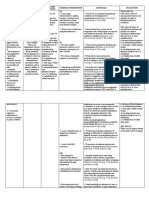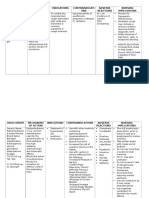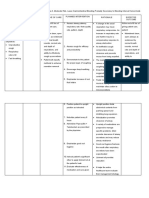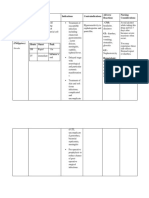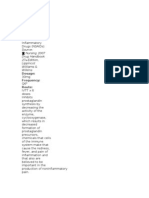Ketorolac
Ketorolac
Uploaded by
Chaotic Insignia LaquianCopyright:
Available Formats
Ketorolac
Ketorolac
Uploaded by
Chaotic Insignia LaquianOriginal Title
Copyright
Available Formats
Share this document
Did you find this document useful?
Is this content inappropriate?
Copyright:
Available Formats
Ketorolac
Ketorolac
Uploaded by
Chaotic Insignia LaquianCopyright:
Available Formats
DRUG STUDY CLASSIFICATION/ MECHANISM OF ACTION Inhibit prostaglandin synthesis by competitive blocking of the enzyme cyclooxygenase (COX).
Ketorolac is a non selective COX inhibitor. SIDE EFFECTS/ ADVERSE REACTION
Headache Abdominal pain (or stomach pain) Nausea Heartburn or indigestion Diarrhea Dizziness Drowsiness Swelling.
DRUGS Generic: Ketorolac Brand: Toradol Classification: Analgesic, NSAID
INDICATION Used for treating inflammation and pain in the operation site
CONTRAINDICATION Hypersensitivity to ketorolac, aspirin, other NSAIDs, or any component of the formulation; patients who have developed nasal polyps, angioedema, or bronchospastic reactions to other NSAIDs; active or history of peptic ulcer disease; recent or history of GI bleeding or perforation; patie nts with advanced renal disease or risk of renal failure; labor and delivery; nursing mothers; prophylaxis befor e major surgery; suspected or confirmed cerebrovascular bleeding.
SPECIAL PRECAUTION/ NURSING RESPONSIBILITY Inform patient that medication may cause respiratory and CNS depression. Instruct client to avoid taking ketorolac with aspirin or other NSAIDs such as ibuprofen(Motrin, Advil),naproxen (Aleve, Naprosyn), piroxicam (Feldene), etc. Monitor for signs of pain relief, such as an increased appetite and activity Instruct client to avoid alcohol and maintain adequate hydration (23L/day of fluids) unless instructed to restrict fluid intake. Instruct patient to avoid taking any new medication during therapy without consulting prescriber Inform patient that the medication may cause drowsiness, dizziness, or fatigue (use cautionwhen driving or engaging in tasksrequiring alertness).
Dosage: 30mg Route:
IVTT
Frequency: Q6h
Timing:
You might also like
- Drug AnalysisDocument3 pagesDrug AnalysisAbby BorabienNo ratings yet
- Drug Name Mechanism of Action Indication Contraindication Adverse Effect Nursing ResponsibilitiesDocument4 pagesDrug Name Mechanism of Action Indication Contraindication Adverse Effect Nursing Responsibilitiesangel cenaNo ratings yet
- Drug Study RopivacaineDocument2 pagesDrug Study Ropivacainerica sebabillonesNo ratings yet
- Drug Study: San Francisco St. Butuan City 8600, Region XIII Caraga, PhilippinesDocument2 pagesDrug Study: San Francisco St. Butuan City 8600, Region XIII Caraga, PhilippinesNikki Caryl ZafraNo ratings yet
- Drug Study Duavent.Document1 pageDrug Study Duavent.Clariss AlotaNo ratings yet
- Drug Study of Mannitol RMCDocument1 pageDrug Study of Mannitol RMCAdrian Ardamil0% (1)
- DS VigocidDocument1 pageDS VigocidasdasdNo ratings yet
- UnasynDocument1 pageUnasynrachieeeNo ratings yet
- Drug Study. GeamhDocument5 pagesDrug Study. GeamhMacky RobentaNo ratings yet
- Generic Name: - Ceftazidime Brand Name: - Tazidime ClassificationDocument2 pagesGeneric Name: - Ceftazidime Brand Name: - Tazidime ClassificationRadicalRayNo ratings yet
- AmpicillinDocument2 pagesAmpicillinMar OrdanzaNo ratings yet
- Drug Name Mechanism of Action Indication Side Effects Nursing Reponsibilities Generic NameDocument4 pagesDrug Name Mechanism of Action Indication Side Effects Nursing Reponsibilities Generic NamehahahaNo ratings yet
- Drug Study QIDocument8 pagesDrug Study QImaeDonitaNo ratings yet
- DRUG STUDY (Diethystilbestrol)Document2 pagesDRUG STUDY (Diethystilbestrol)Avianna CalliopeNo ratings yet
- Drug Mechanism of Action Indications Contraindications Side Effects & Adverse Effects Nursing Responsibilities Generic Name: Side EffectsDocument1 pageDrug Mechanism of Action Indications Contraindications Side Effects & Adverse Effects Nursing Responsibilities Generic Name: Side EffectsHanna SeNo ratings yet
- DRUG STUDY AtorvastatinDocument1 pageDRUG STUDY AtorvastatinKyla BeconiaNo ratings yet
- Drug Name Mechanism of Action Administration Indications Contraindications Adverse Reactions Nursing ResponsibilitiesDocument1 pageDrug Name Mechanism of Action Administration Indications Contraindications Adverse Reactions Nursing ResponsibilitiesIvan Liquiran AvenadoNo ratings yet
- Drug Study Cefuroxime.Document1 pageDrug Study Cefuroxime.Clariss AlotaNo ratings yet
- Drug Study AzathioprineDocument3 pagesDrug Study AzathioprineBunnie AlphaNo ratings yet
- PNSSDocument2 pagesPNSSBianca Nicole Gacad FernandezNo ratings yet
- NeoblocDocument2 pagesNeoblocianecunar100% (2)
- NCP For Acute PainDocument4 pagesNCP For Acute PainimnasNo ratings yet
- DrugStudy and NCP For CDDocument11 pagesDrugStudy and NCP For CDHoney FranciscoNo ratings yet
- DORMICUMDocument1 pageDORMICUMArian Rose100% (1)
- Gatchalian Drug StudyDocument2 pagesGatchalian Drug StudyAnna Sofia ReyesNo ratings yet
- Co AmoxiclavDocument2 pagesCo AmoxiclavkaijeiNo ratings yet
- BiogesicDocument2 pagesBiogesicianecunarNo ratings yet
- Senokot-S (Senna Concentrate 8.6mg + Docusate Sodium 50mg)Document2 pagesSenokot-S (Senna Concentrate 8.6mg + Docusate Sodium 50mg)E100% (1)
- Duavent Drug Study - CunadoDocument3 pagesDuavent Drug Study - CunadoLexa Moreene Cu�adoNo ratings yet
- Bacillus Clausii ErcefloraDocument1 pageBacillus Clausii ErcefloraCezhille BattadNo ratings yet
- Cap Nursing Care PlanDocument6 pagesCap Nursing Care PlanCharlene Grace ReginoNo ratings yet
- GliclazideDocument5 pagesGliclazideGwyn RosalesNo ratings yet
- CalmoseptineDocument2 pagesCalmoseptineMonique Chua 蔡仁安No ratings yet
- ApidraDocument4 pagesApidraRobert Ivan AgujarNo ratings yet
- XtendaDocument2 pagesXtendaAlexis CoronadoNo ratings yet
- Drug Study NurseryDocument6 pagesDrug Study NurseryPau-pau BasiNo ratings yet
- GCP Cs DrugsDocument13 pagesGCP Cs DrugsBel CortezNo ratings yet
- Drug Study ICUDocument5 pagesDrug Study ICUEcko MoawiaNo ratings yet
- DoxofyllineDocument2 pagesDoxofylline3C LAGRANA, Rea Lyn F.No ratings yet
- NCP 1 1Document10 pagesNCP 1 1Samantha VeraNo ratings yet
- Drug Study OmeprazoleDocument3 pagesDrug Study OmeprazoleSandeepNo ratings yet
- Drug Study Ciprofloxacin QuinosynDocument3 pagesDrug Study Ciprofloxacin QuinosynEmmanuel Margate100% (1)
- Docu - Tips Drug StudyDocument14 pagesDocu - Tips Drug StudyArdel LabadaNo ratings yet
- Solu CortefDocument1 pageSolu CortefKristine YoungNo ratings yet
- KetorolacDocument1 pageKetorolacAngela Tenorio100% (1)
- Endorsement Week 9Document13 pagesEndorsement Week 9MICHELLE FACTONo ratings yet
- Drug StudyDocument4 pagesDrug StudyAilah Mae Dela Cruz0% (1)
- BiperidenDocument1 pageBiperidenMFQ.RN100% (2)
- Actos Drug StudyDocument2 pagesActos Drug StudyNathalie kate petallarNo ratings yet
- DRUG STUDY CLOBETASOL CREAMrevisedDocument2 pagesDRUG STUDY CLOBETASOL CREAMrevisedswitchlers anneNo ratings yet
- EscitalopramDocument1 pageEscitalopramRicky Ramos Jr.No ratings yet
- ParecoxibDocument2 pagesParecoxibPeetah PanNo ratings yet
- CiticolineDocument1 pageCiticolineHarvey BanagNo ratings yet
- Clarithromycin Drug StudyDocument1 pageClarithromycin Drug StudyDivine LavaNo ratings yet
- CetirizineDocument1 pageCetirizineGabby Robles PajeNo ratings yet
- Cefuroxime Drug AnaDocument4 pagesCefuroxime Drug AnaCarpz DarpzNo ratings yet
- Neuropathic Pain Diabetic Peripheral NeuropathyDocument7 pagesNeuropathic Pain Diabetic Peripheral NeuropathyJomabee TuArNo ratings yet
- Drug NameDocument2 pagesDrug NameSarah Agudo FernandezNo ratings yet
- Generic Name: Brand Name: Classification:: Source: Drug Handbook 27 Edition, Lippincot Williams & WilkinsDocument11 pagesGeneric Name: Brand Name: Classification:: Source: Drug Handbook 27 Edition, Lippincot Williams & WilkinsVel Georgia-FrancoNo ratings yet
- Name of Drug Mechanism of Action Indications Contra-Indications Side Effects Nursing ConsiderationsDocument10 pagesName of Drug Mechanism of Action Indications Contra-Indications Side Effects Nursing ConsiderationsmidskiescreamzNo ratings yet





















